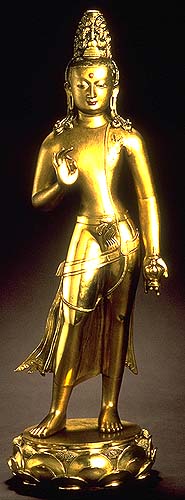|
Maitreya, the Buddha of the Future, is the harbinger of a new age, who awaits his final rebirth as Buddha in his Tushita Heaven of Joy. His role was especially celebrated in the pantheon and rituals of the reformed Gelugpa order as the next Buddha as well as the source of a significant group of tantras. Tsongkhapa named his first monastery Ganden, after Maitreya's heaven, and he and his followers "went to Ganden" when they died. Maitreya fulfilled many needs, both spiritual and political. He was the anointed heir-apparent to Shakyamuni and the model for kings and emperors who saw themselves as enlightened chakravartin world rulers. Tibetan and Mongolian monasteries usually housed Maitreya images, which were used in the annual Maitreya Festival instituted by Tsongkhapa in 1409 and promulgated in Mongolia by Zanabazar after his miraculous, fateful visit with the Panchen Lama in 1655. Held at the New Year in Da Khree (Urga), the Maitreya Festival had great appeal to Buddhists in Tibet and Mongolia yearning for stability after years of political uncertainty. Zanabazar must have understood the complex ramifications of his devotion to Maitreya; he is known to have focused on him in his own prayers and practice. He also cast images of the Future Buddha, several of which survive. At least two representations of Maitreya attributed to Zanabazar's hand follow a classic, Nepalese-inspired model, best seen in a Tibetan Maitreya from Narthang, dated to 1190 (fig. 1). One is now kept at Gandantegchinlin Monastery in Ulaanbaatar (fig. 2) and the second and larger of the two, seen here, was the very Maitreya used in the annual festival held at Da Khree, Zanabazar's monastic encampment. Yet another, strikingly similar image, which bears all the earmarks of Zanabazar's own work, has a double-lobed aureole and a square pedestal (see Bartholomew, "Introduction to the Art of Mongolia," fig. 5). In all these works, the Future Buddha is shown as a young bodhisattva. His hair, once washed blue, is piled high in a Brahmanic style that repeats the form of the stupa-reliquary resting above his brow. He holds in his left hand a kundika bottle filled with the elixir of immortality and raises his right hand in the vitarka mudra, the gesture of argumentation. His nearly evanescent dhoti is ringed by two sashes and crossed with a Brahmanic thread. A flayed antelope skin covers his left shoulder. The lotus pedestal that supports his smooth, flat, nearly ankleless feet is radically simplified into a form Zanabazar often used, with two rows of upturned petals interspersed with round tipped stamens. -P.B. Published: Tsultem, Mongolian Sculpture, fig. 78; BÈguin, TrÈsors de Mongolie, no. 6 |
<< previous image || Mongolian Exhibition || next image >>
